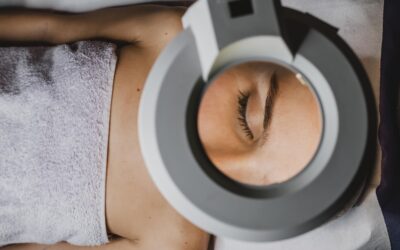Acne scars can feel like a cruel reminder of battles your skin has already fought. Long after the last pimple has healed, these permanent marks remain as evidence of your skin’s struggle with inflammation.
If you’ve been searching for how to get rid of acne scars, the good news is that modern acne treatment options, especially advanced laser technology, offer real hope. These cutting-edge treatments can dramatically improve the appearance of acne scars and help restore smoother, more even-toned skin.
The Complex Story of How Acne Scars Form
Understanding acne scarring requires looking beyond the surface to see what happens deep within your skin during the inflammatory process. When a pimple forms, it’s actually a complex inflammatory response involving your immune system, bacteria, and tissue damage.
Acne scars form when inflammation damages the collagen and elastin fibers in your dermis, the deeper layer that provides skin structure. Your body attempts to repair this damage by producing new collagen, but the repair process doesn’t always go smoothly. Sometimes your body produces too little collagen, resulting in depressed scars, or too much collagen, creating raised scars.
Here’s something fascinating that most people don’t realize: the severity of your acne doesn’t always predict scarring severity. Some people with mild acne develop significant scarring, while others with severe acne heal with minimal damage. This variation comes down to individual differences in inflammatory response, genetics, and treatment timing.
The timing of scar formation is more complex than many understand. While some scarring occurs during active inflammation, additional remodeling can continue for months or years after acne clears. Your skin has a remarkable ability to continue repairing scar tissue long after initial damage occurred.
Types of Acne Scars and Your Immune System’s Role
The three main types of depressed acne scars each require different treatment strategies. Icepick scars are narrow and deep, resembling puncture wounds. Boxcar scars are wider with defined edges and flat bottoms. Rolling scars create a wave-like appearance caused by fibrous bands pulling the surface downward.
Recent research reveals fascinating insights into how your immune system influences scar formation. Neutrophils are first responders that fight infection but can cause collateral damage to healthy tissue. Macrophages clean up debris but can perpetuate inflammation when overactive. People with severe scarring often have imbalanced inflammatory responses that damage more tissue than necessary.
Why CO2 Lasers Reign Supreme for Acne Scars
Carbon dioxide lasers have established themselves as the gold standard because they address the fundamental problem: disorganized or insufficient collagen in the dermis. These lasers work at depths and precision that other treatments cannot match.
CO2 lasers operate at 10,600 nanometers, perfectly absorbed by water molecules in skin. Since skin is 70% water, CO2 lasers can precisely vaporize tissue while creating controlled thermal damage that stimulates healing and collagen remodeling.
What makes CO2 lasers uniquely effective is their ability to create both ablative (tissue removal) and coagulative (tissue heating) effects simultaneously. The laser removes damaged surface tissue while heating deeper dermis to temperatures that stimulate new, organized collagen production.
The depth of penetration – up to 4 millimeters – allows CO2 treatments to reach deeper dermis layers where acne damage typically occurs. This addresses structural problems creating scar appearance, not just surface issues. CO2 lasers are particularly effective for icepick and boxcar scars because they vaporize scar tissue while stimulating walls and base to contract and fill with new collagen.
The Limitations of CO2 Treatment
Despite effectiveness, CO2 lasers have limitations. While they dramatically improve scar appearance, they rarely eliminate scars completely. Most patients can expect 50-80% improvement, which is often life-changing. Very deep icepick scars may require multiple, aggressive treatments.
The Revolutionary Advance of Deka Technology
Traditional CO2 treatments were notorious for brutal recovery periods involving weeks of being indoors and days of bleeding, oozing, crusting, and peeling. The Deka Tetra CO2 system represents a paradigm shift in energy delivery, achieving superior results with dramatically improved healing.
The key innovation lies in precise energy control and ability to operate in multiple modes during single treatments. Unlike older systems with basic, one-size-fits-all approaches, the Deka Tetra adjusts pulse duration, energy density, and pattern geometry with unique precision.
This precision allows practitioners to create “optimal thermal damage zones” – controlled tissue injury that maximizes collagen stimulation while minimizing unnecessary trauma to healthy skin tissue. Results include strong healing responses (necessary for the creation of new collagen) without excessive inflammation and tissue destruction.
How Deka Technology Optimizes Immune Response and Collagen Production
Deka technology heals so much better because it creates the perfect amount of healing response in your skin. Think of it like this: older laser treatments were like using a sledgehammer when you needed a precision tool. They created so much damage that your skin couldn’t heal properly, leading to weeks of painful recovery.
Deka works more like a skilled surgeon. It creates tiny, perfectly sized treatment spots that tell your skin exactly where to heal without damaging too much healthy tissue around them. These small treatment areas send clear “fix me” signals to your body’s repair system without overwhelming it.
Here’s what makes this approach so smart: Deka leaves patches of completely healthy skin between the treatment spots. This healthy skin acts like a first aid station, sending healing cells and repair materials to the treated areas super quickly. It’s like having rescue teams stationed right next to where they’re needed most.
The type of collagen that grows back is also much better with Deka technology. Old treatments often created messy, disorganized collagen that didn’t make skin look smooth. Deka stimulates your skin to grow new collagen in neat, organized patterns just like healthy skin naturally has. This organized collagen is what gives you that smooth, natural-looking result.
Deka can also work in different ways during the same treatment session. It can remove damaged surface skin, tighten deeper skin layers, and stimulate new collagen growth all at once. This all-in-one approach gives better results than treatments that can only do one thing at a time.
Recovery and Results
Modern CO2 treatments with Deka technology involve 3-7 days of redness, mild swelling, and light flaking rather than weeks of intensive healing. Most dramatic improvements appear several months after treatment as new collagen forms, with continued improvement up to one year.
Prevention and Hope for the Future
Preventing new scarring through early acne treatment, avoiding picking, sun protection, and regular retinoid use is crucial. While complete scar elimination isn’t always possible, improvements achievable with today’s treatments are often life-changing. Most patients find 50-70% improvement sufficient to restore confidence and comfort in their skin.
The future continues evolving with new technologies, but fundamental principles remain: controlled tissue injury, optimal collagen stimulation, and precise energy delivery. With advanced treatments now available, clear, smooth skin is no longer just a dream but an achievable reality for most people dealing with acne scarring.




